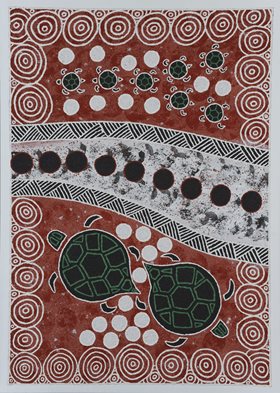.aspx) Journeying in his own land
Journeying in his own land
Rod Garlett by Geoff Vivian
If you visit Rod Garlett’s Midland home studio you will see a dozen or so paintings stacked against the wall. They have an unusual texture. The layers of natural ochres and acrylic are thick, but not through any typical impasto technique. They have a gritty texture because he mixes the colours with sand. Rod will tell you this is no ordinary sand. It all comes from Gugulga, at a permanent spring-fed pool on the Avon River that is sacred to his family.
“I believe the Rainbow Serpent has rubbed his belly up upon the sand, and has put magic there,” he says. “It’s what makes my painting unique. I seldom see artworks in the galleries with the thickness of my river sand art.
“I always wanted to find my own style, getting away from the dot work that I mainly found to be the art of the remote people, though many have adapted to it today. I remember as a young child it was always our landscapes that our people of the south painted. They used watercolour, charcoal, ochre and bark painting. I remember quite fondly me and my uncle picking the bark from the island in the river in Northam, which we call Narrjuk.
 “When we go out to collect the ochre we don’t just take it from the land. We ask the ancestors, or the spirits of that place, if it will be alright, so we can paint the stories of our people.”
“When we go out to collect the ochre we don’t just take it from the land. We ask the ancestors, or the spirits of that place, if it will be alright, so we can paint the stories of our people.”
Rod says he spent most of his life in his home town of Northam. His late uncle was an accomplished bark painter and taught younger men the art. “I miss him but you get to walk alongside them for a while for a reason,” Rod says. “When they go you must carry on the stories and remember the sites that they showed you and always care for them.”
As an Aboriginal man with Yued, Ballardong and Wadjuk heritage, Rod began painting stories based on significant sites of his ancestors, and ancestral beings. He places tremendous importance on the fact that he lives and works in his ancestral Avon, Swan and Canning River country.
“It’s a huge bonus to be able to paint from a country where your inheritance lies, your spirit is connected, where you’ve been born, where you have lived,” he says. “And also a place where you’ve been taught culture. Taught by the Elders, the stories of that place, their meaning and how they fit with us today and how we will walk the rest of our journey.”
He is standing a short distance from the sacred pool, and picks up a handful of that special sand.
“It’s sad because the sand tells another story about country, about destruction of country,” he says. “It’s the topsoil of the farmlands. All the natural barriers that were holding country together are now allowing country to fall apart. So the topsoil is the sand that’s falling into the river that will eventually choke the river system.”
Geoff Vivian, a former studio artist, is a freelance writer and photojournalist who has also spent more than a decade working in community development for local councils and as the manager of the Aboriginal radio station at Halls Creek.
This article featured in the Artsource Newsletter, Winter 2014.